A mid-weight worker placement game with pick-up and deliver and auction elements wrapped up in a scenic train theme of building the Canadian Transcontinental Railroad
75-150 minutes
Designer: Glen Dresser
Publisher: Wheelhouse Games
We are big fans of trains here in the Wozniak house. Sarah has always had a thing for trains that probably goes back to her grandpa working for the railroad, collecting model trains, and being dragged as a kid to more than a handful of antique toy shows. Emily grew up 15 min from the Henry Ford Museum in Dearborn, MI, and spent her childhood obsessing over all things that move.
We got married on a train car, in a train museum. We had train wedding favors. We even took a train ride on our honeymoon. (Okay, too much, dial it down a bit).
We just like trains.
So, to go full steam ahead, here is our pre-Kickstarter review of The Transcontinental.

The Transcontinental is scheduled to launch on Kickstarter on November 10
Follow it [HERE] for updates and to catch the release!
Note: A prototype copy of The Transcontinental was generously provided to us by the publisher for a pre-Kickstarter review. There may be changes in art and quality between the version we played and the Kickstarter version that don’t impact overall gameplay.
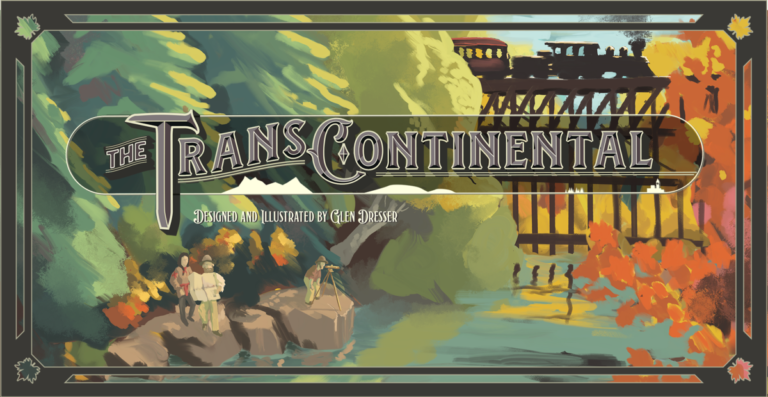
Gameplay Overview
In 1871, with Canada only 4 years old, the Prime Minister calls for a massive undertaking: a transcontinental railway to link the established eastern provinces with the newly-added western province. Between them lay the vast, undeveloped interior. It would be a nation-defining project, opening up the resource-rich Canadian shield, the fertile prairies, and the breathtaking Rocky Mountains, shaping not only the economy of the young country but its identity as well.
At its core, The Transcontinental is a worker placement and action selection game with some elements of pick-up and deliver, as well as bidding. Players load and unload resources from the train to build buildings along the rail line.
Throughout the game, players will place telegram markers on action spaces going west, execute those actions, bid for tiles to advance the railroad, and then return east, once again placing any remaining, available telegram markers and executing actions.
Setup
Each player begins the game with a player shield that hides their various pieces and starting resources: telegram markers, development buildings, resource cubes, bidding discs, an ally, and an investment. There are two main boards – the “train” and the “track”. The track – pictured below has a semi-randomized setup that lends itself well to re-playability.
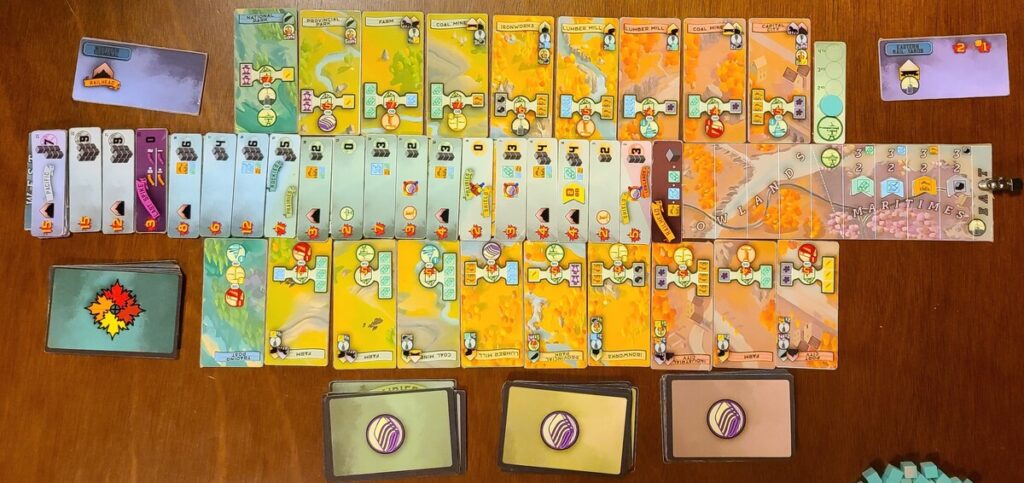
Round Overview
Note: this is a general overview of gameplay in order to provide context for the review, and not a detailed how-to-play.
The round structure is part of what makes this unique among worker-placement games. It’s relatively straightforward, but there are a lot of subtle details that can be hard to incorporate into your strategy on the first go. Here is a overview of a round:
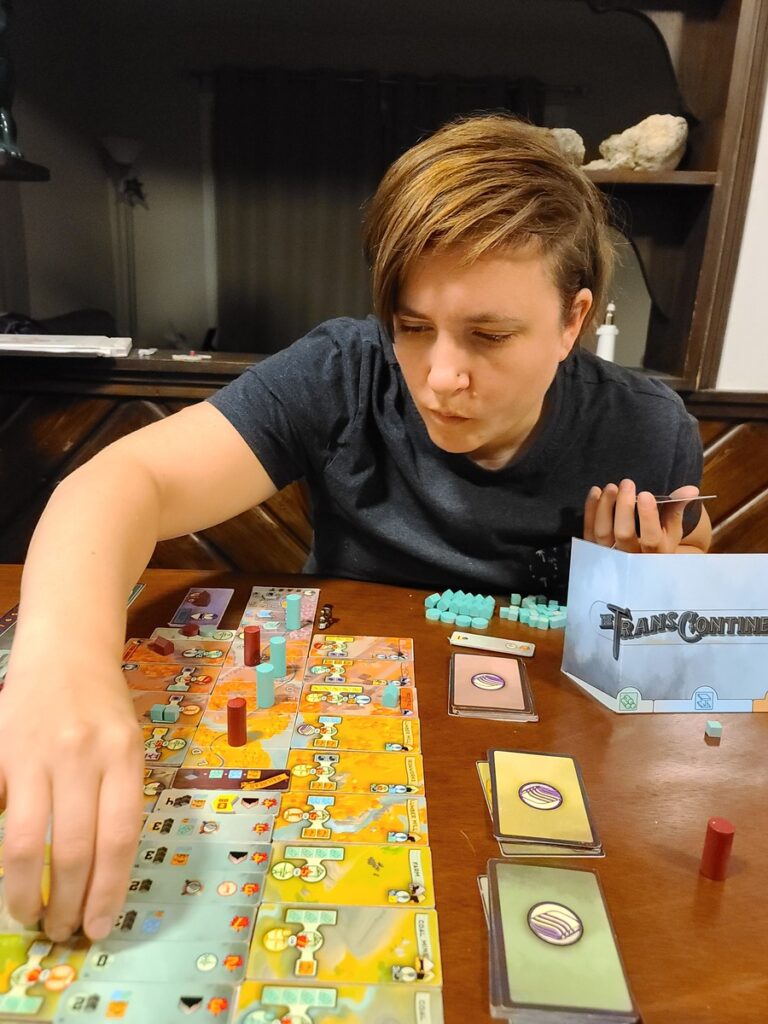
- Westbound Telegram Phase: Place 0-3 telegrams (workers) in turn order
- Each action spot has 2 associated actions that can be done in any order.
- Remember – you only have 3 total for a typical round, so if you place all 3 during the “westbound” phase, you won’t have any left for the “eastbound” phase
- All players place telegrams in turn order before moving on to action phase
- Westbound Actions Phase: Execute actions sequentially from East to West
- Load resources onto the train using a variety of methods:
- Port Supply – add the indicated number of that resource to the train
- Production – add the indicated number of the resource(s) on the building to the train (must have player’s house on the building)
- Acquire – add any one resource of your choice to the train
- Trade – change up to 2 of your resources on the train to a different resource type
- Unload resources to the railway
- Develop – “deliver” resources from the train to the building with your telegram
- Other players might end up choosing to “follow” if their resources are immediately behind the delivered resource on the train
- Portage – deliver one resource to any building (regardless of where your telegram is)
- If the building is complete from either develop or portage (has all required resources), flip the tile and the player with the most contributed resources takes points and builds a house
- Develop – “deliver” resources from the train to the building with your telegram
- At any time, a player may choo-choo-choose to play an Ally card that can improve a turn or amplify an action
- Load resources onto the train using a variety of methods:
- Railhead Phase: After all actions from westbound telegrams are complete, players bid resources to advance the rail beyond the wilderness expanding the railroad further west. The bidding process is fairly unique, with the pooled bids deciding how far west the rail extends that round. Highest bidders get first pick of tiles that give points or resources. Note: you bid with your resources, so if you drain your supply you might not have enough for your next actions!
- Eastern Telegram Phase: Place 0-3 telegrams (workers) that are “unused” from the westbound phase in turn order
- Eastbound Actions Phase: Execute actions as the train moves from West to East (same as above)
- Cleanup: Check for resupply and remove any unused telegrams
End of Game
The game ends when the Last Spike tile is claimed, advancing the railroad to the end of the line. In the last round, the Eastbound phase is not played.
What do we think?
In short, we loved it. The Transcontinental is a really fun take on a worker placement game. We’d classify it as a medium-heavy game, which is where most of our favorites lie on the weighting scale. It has very little randomization (luck) and at every point in the game you feel like you control your destiny. You win or lose based on your decisions, which is both very stressful and very fun.
What did we like?
For us, this game just worked. It was heavy enough that we felt challenged, but it was relatively short at 2 players for the level of complexity (we could get a 2-player game in around that 75 min mark once we knew how to play). It has great pacing – you have quite a few options to choose from right out of the gate, and as the game chugs along and you build your engines, those choices increase steadily in complexity.
There are two potential telegram placement phases (Westbound and Eastbound) plus any potential bonus telegrams that you get during your turn. Placing a telegram gets you access to both actions on the tiles adjacent to the space. This allows for some satisfying action chaining to come together using the benefit from the first action to complete the second.
If you’ve read our reviews before, you know that we love action chaining, getting a bunch of stuff, and doing a bunch of stuff. The Transcontinental has that on nearly every turn…but you have to work for it.
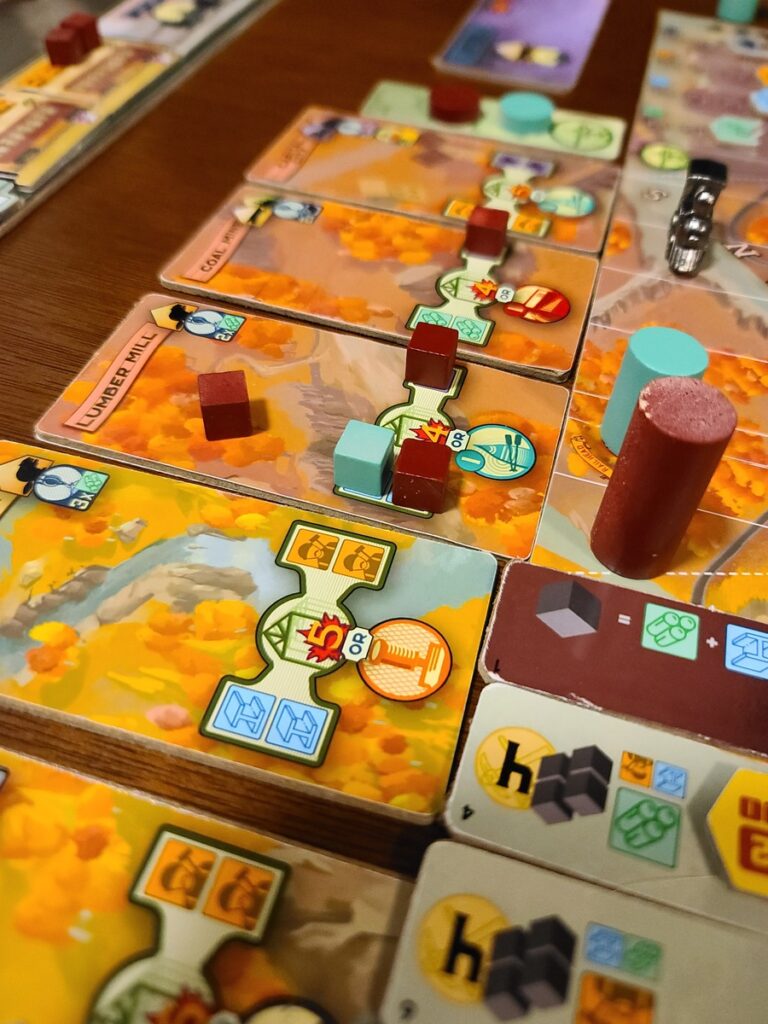
We’re also impressed by Glen Dresser, who both designed the game and did the artwork. The art feels very time-period and location-appropriate and the art style is stand out for what is usually a very dark, industrial theme. He also really did his homework in researching the Canadian Transcontinental railroad. All the ally cards feature prominent historical figures important in shaping this part of Canadian industrial history.
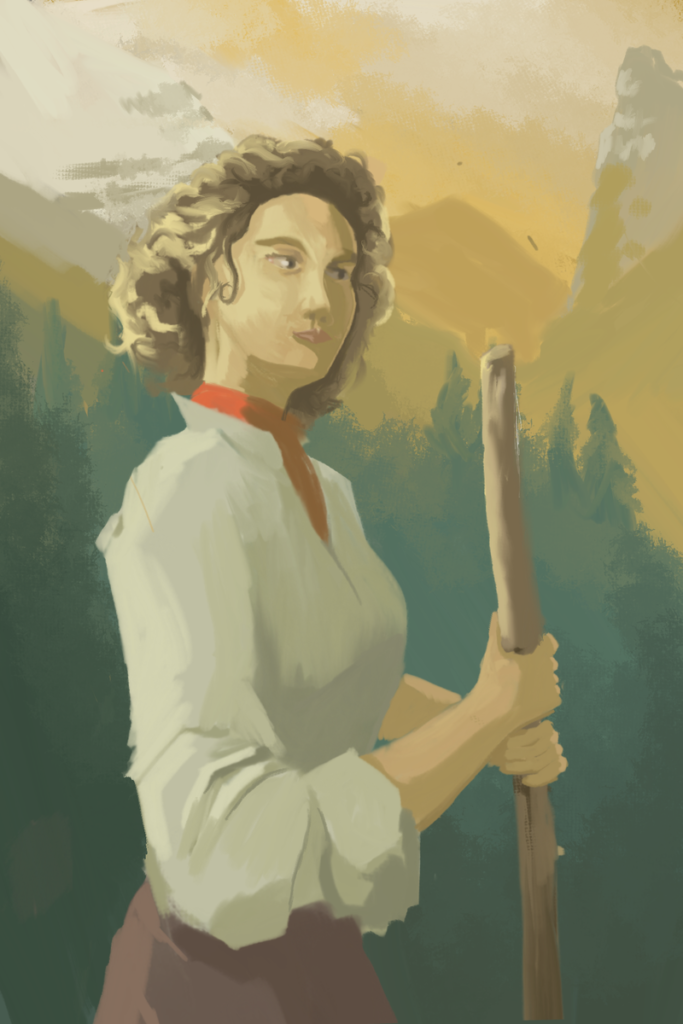
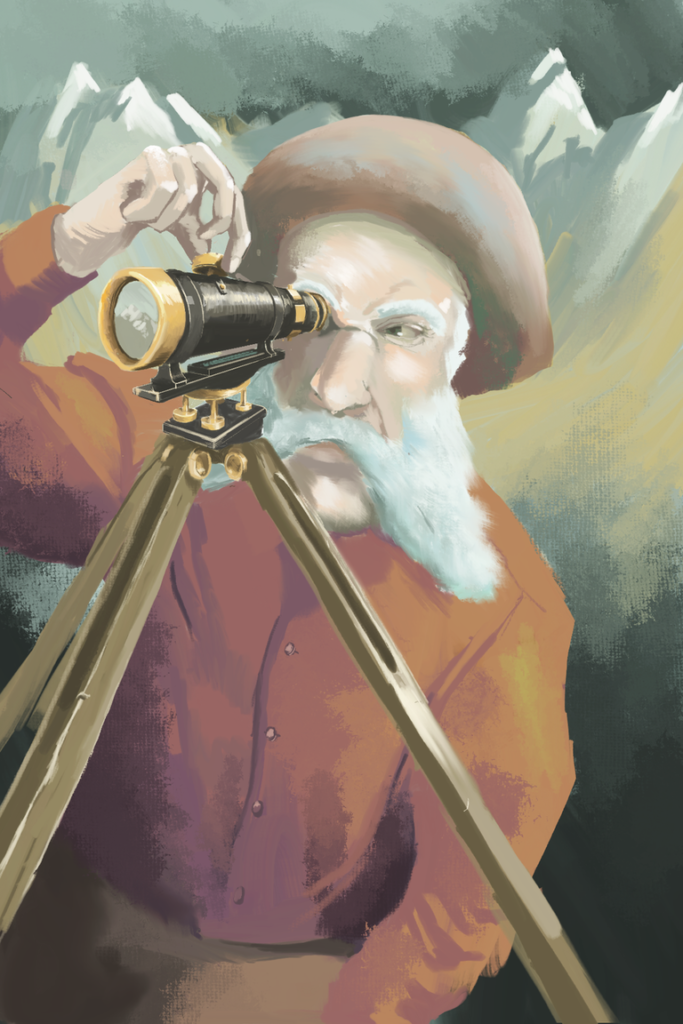
What didn't work?
Our few complaints are minor and didn’t really impact our enjoyment of the game. One is that it can get very “fiddly” at times with moving resources around and it can be hard to keep track of them. There are a lot of tiny adjustments being made to the location of the cubes for each action, and it does take some getting used to before you can reliably perform some of the actions with confidence that you did it right.
There is also a lot of terminology (portage, acquire, develop) for the different actions that weren’t immediately obvious to us what they meant and so keeping them all straight took a game or two. The prototype copy did come with a fairly comprehensive player guide printed on the player screen that was a pretty good reminder.
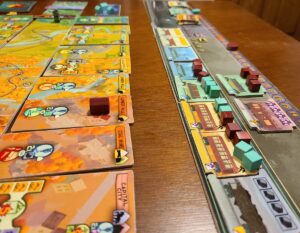
The one thing that didn’t scale to 2-players very well for us were the “investments” (goal cards). At 2 players, we found that we could essentially ignore our investment cards and still naturally achieve them throughout the course of the game, most likely due to the relative freedom that comes from a less crowded game.
Who will like this game?
For us, this game falls perfectly into that category of challenging-but-fun. BGG currently has this listed as a solid medium-weight, but we feel it leans just a bit more towards medium-heavy. The complexity of the rules is relatively low, but the various strategies are a lot more subtle and chaining them together efficiently is tough. You might like this game if you’re a fan of other worker-placement games like Ragusa, Empyreal: Spells & Steam, Lorenzo il Magnifico, Tzolk’in, or even Agricola. We hope we’re not completely off the rails here, but we think The Transcontinental “feel” is most similar to games like Ragusa in weight, or like a lighter, yet slightly more dynamic version of Agricola.
Sarah's Take
I’m a big fan of The Transcontinental.
The ability to do two actions at one worker placement spot is really fun. It adds a whole layer of strategy in not only planning which spot you’re aiming for, but also needing to time each action just right. It also makes the game, which is pretty tight, feel more open and gives you a greater sense of control.
The planning and execution of a strategy in each turn is extremely satisfying. If you don’t have a plan or can’t anticipate what your opponent may try to do, you’re going get derailed. You will not do well placing willy nilly or just doing an action because it is available to you. I learned the hard way not to blow all my resources flipping development tiles and had nothing left to bid with, giving Emily easy access to tiles in the Railhead phase netting her both points and bonuses that I didn’t get.
There’s something about The Transcontinental that makes Emily paralyzed with indecision and uncertainty. It’s extremely satisfying to get into her head, yet she has beat me every time we’ve played…
The Transcontinental hits a lot of sweet spots for me and is an instaback on Kickstarter for us.
Emily's Take
I typically gravitate towards sandboxy games where there are a thousand possible actions, so I was surprised at how much I liked The Transcontinental. Despite playing very tight with only 3 “workers”, I felt like there was a good balance of different options and strategies that could work, and having 2 actions per space that change game-to-game makes it feel more open. Unlike other super constrained games like Agricola, I like that this game has enough set-up variability that the same strategy will definitely not work for every game.
It is also a brain-melter at times. Because of the way the actions are executed sequentially based on heading west or east along the board (instead of turn order), you have to place your telegrams based on what the resource board is going to look like when that telegram (worker) is activated. Basically, you have to map out the entire round in your head while you’re planning worker placement, then make adjustments based on what the other player is doing. There were countless times when I was my own worst enemy and messed up a later action by not planning it out right based on the sequential activation mechanic. And that’s not even mentioning taking the other player’s actions or the mid-round bidding phase into account.
Rulebook / Learning the Game
*We should note that we played a prototype copy of the game and there could be changes to wording or layout in the final version of the rulebook.
This game isn’t that complex in essence, but there are a lot of subtle rules to keep track of. The rulebook itself was fairly short and straightforward, but we found ourselves needed to return to it for reference often throughout the first game. Our big complaint here was the relatively large number of new terms for all the different actions for moving resources around (portage, acquire, port supply, production, etc). Since many actions are very similar to one another with slight differences, it was tough to remember at first. Honestly the player aide printed on the back of the player screen was incredibly useful for helping to remember all the actions and what the terms mean.
First Play
The first game was definitely a “learning game”. The Transcontinental is somewhat forgiving of a few early-on mistakes, but VERY unforgiving of mid-game mistakes. Neither of us really had any sort of a plan or strategy until nearly the very end, but that led us into wanting to play again almost right away.
Subsequent Plays
Once we realized the obvious – that the randomized distribution of the tiles means each game will be different – we were super excited to try again. We kept saying things like, “oh, imagine if this tile was across from this tile! What glorious action chaining!” We also both tried out several different strategies, and didn’t yet find one that was the clear “winning strategy”.
Set Up / Clean Up Time
Despite how finicky some of the play can be with resources, it’s actually a pretty quick set up and clean up. The most time-consuming part are the various tiles, but even that’s not bad once you know what to do. After playing 4 times, we can set up in about 10 min (provided no child interruptions) and clean up even faster.
Play Time, Best Number of Players
The play time guidance is 75-150 minutes, but for a 2-player game we could actually get through in a bit less than 90 minutes (except child interruptions or horrible analysis paralysis – *Emily*).
We weren’t able to get a multiplayer game in, so we can’t speak to higher player counts, but this game worked very well as a 2-player game. Since we most often play 2-player, we’re excited to have found a great medium-heavy Euro game that works really well.
Parent Perspective
Interruptions
The Transcontinental isn’t a great game for interruptions. It requires a lot of focus and planning ahead. If you need a pause, definitely try to time it between rounds or you’ll very likely lose your train of thought.
Life Fit
This is a great game for when you’re looking for a real challenge and you really want to flex your brain without a huge time investment. We did play a few times on weeknights, but due to the length and complexity it’s not the best for the end of a “long” day. Tackle this one when you have enough brain power and energy to put into strategizing.
Rating
Overall Rating: 8/10
This is just a downright great game. We love a lot of different games, but Euros in this weight class that play well at 2 are hard to come by, and this one fits the bill perfectly. It offers enough challenge that we get super engaged, without getting bogged down or feeling like it drags on forever. If you like medium-heavy Euros, you should definitely consider backing The Transcontinental. It has all the promise of becoming a quick classic, and has earned its place on our shelves among games like Orleans, Agricola, and Ginkgopolis.
*See our rating scale HERE
If you’re interested in the Kickstarter, visit the preview page HERE.
Click through for more posts, or follow us to see what we’re playing and for new post updates!
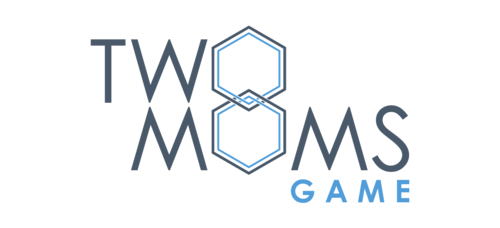
I first became aware of The Transcontinental via awSHUX, and while I didn’t have a chance to play it, it looks very up my alley: worker placement, medium-heavy, semi-obscure historical theme. Your review has pretty much sealed the deal; I’m looking forward to the kickstarter.
Looks like we all get our wishes, it funded so fast! We’re so looking forward to playing the final version!